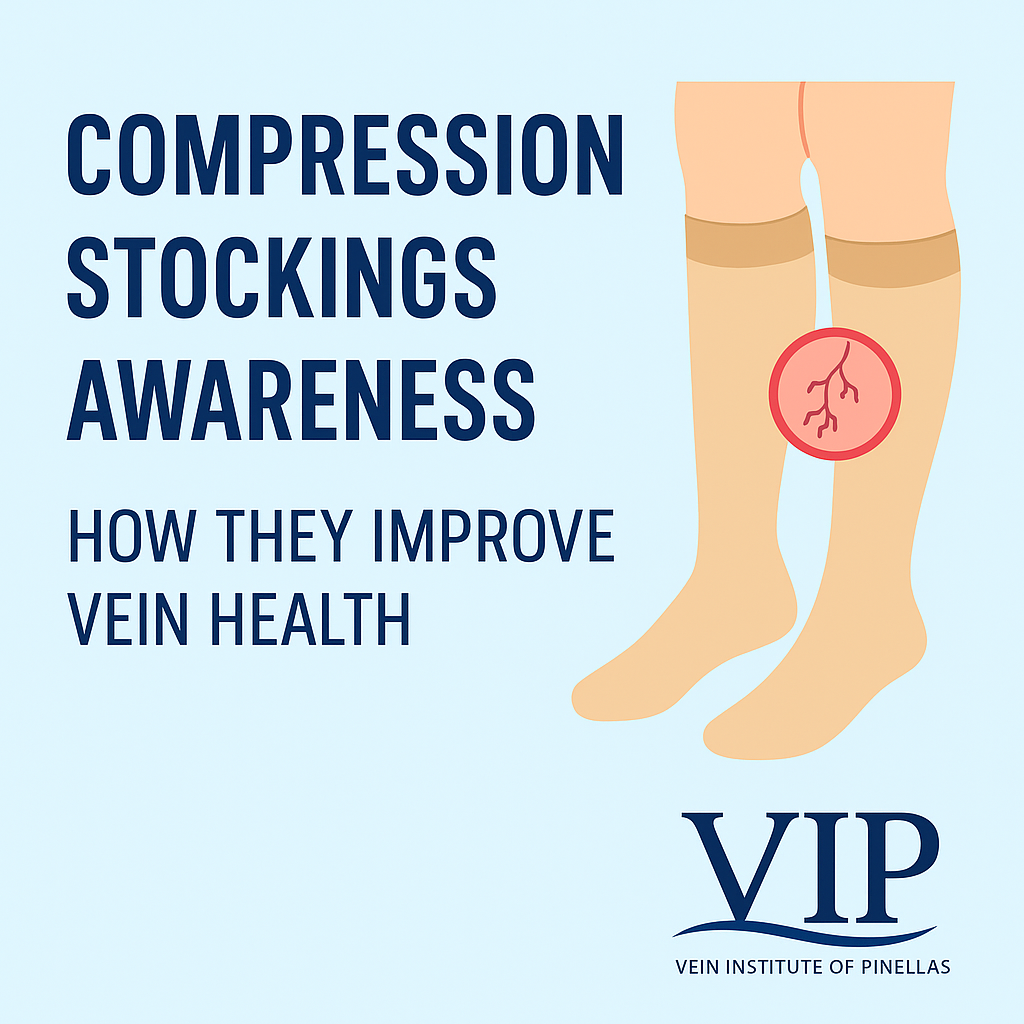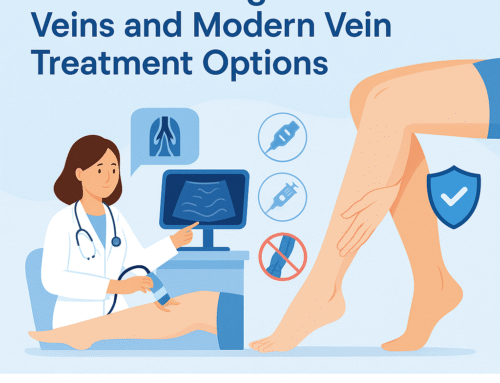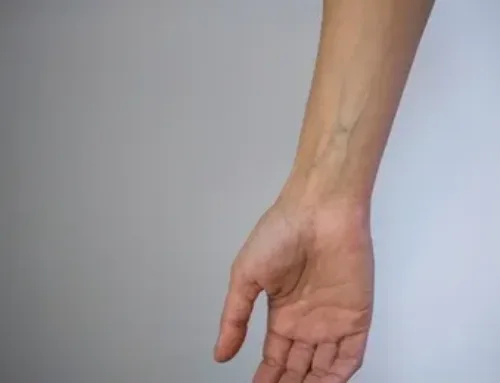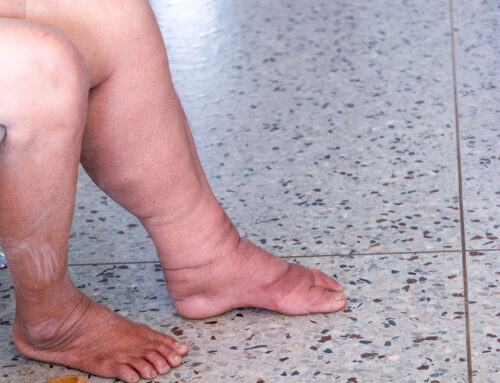Compression Stockings Awareness: How They Improve Vein Health 2025
Introduction
October is the perfect time to highlight Compression Stockings Awareness. These specialized medical garments are more than just tight socks—they are a cornerstone of vein health management. For patients struggling with varicose veins, spider veins, chronic venous insufficiency, or circulation issues, compression stockings provide relief, prevent complications, and support long-term vascular wellness.
At the Vein Institute of Pinellas (VeinsVIP.com), we believe education is the first step in empowering patients. This article will cover everything you need to know about compression stockings—their purpose, types, medical benefits, how to use them correctly, and why they matter for your vascular health.
What Are Compression Stockings?
Compression stockings are specially designed hosiery that apply gentle, graduated pressure to your legs and ankles. This pressure improves circulation by:
-
Helping the veins push blood back toward the heart.
-
Reducing blood pooling in the lower legs.
-
Minimizing swelling and discomfort.
-
Lowering the risk of blood clots (deep vein thrombosis or DVT).
They are prescribed by vein specialists, like those at VeinsVIP, to manage a variety of venous conditions.
Why Compression Stockings Matter for Vein Health
Veins are responsible for transporting blood back to the heart. Unlike arteries, veins rely heavily on surrounding muscles and valves to push blood upward. When vein valves weaken, blood can pool in the legs, causing:
-
Varicose veins (bulging, twisted veins)
-
Spider veins (tiny, visible surface veins)
-
Leg swelling and heaviness
-
Pain, cramping, or throbbing
-
Venous ulcers (serious wounds from poor circulation)
Compression stockings counteract these issues by restoring proper blood flow and providing external support to the vein walls.
Conditions That Benefit from Compression Stockings
Compression stockings are commonly recommended for:
1. Varicose Veins
They relieve pain, reduce swelling, and slow the progression of varicose veins.
2. Spider Veins
Though cosmetic in nature, stockings help prevent spider veins from worsening.
3. Chronic Venous Insufficiency (CVI)
Stockings provide essential support when vein valves fail, improving blood return.
4. Deep Vein Thrombosis (DVT) Prevention
Particularly important after surgery, long flights, or prolonged bed rest.
5. Pregnancy-Related Swelling
Pregnant women often experience leg swelling and varicose veins; stockings provide safe relief.
6. Post-Vein Treatment Care
After sclerotherapy, radiofrequency ablation, or endovenous laser treatment, compression stockings help veins heal properly.
Types of Compression Stockings
Not all stockings are the same. Your vein specialist will recommend the right option depending on your condition.
1. Graduated Compression Stockings
-
Provide strongest pressure at the ankle and gradually decrease toward the thigh.
-
Most commonly prescribed for venous disease.
2. Anti-Embolism Stockings (TED Hose)
-
Typically used during hospitalization or after surgery.
-
Designed to prevent blood clots in bed-bound patients.
3. Non-Medical Support Hosiery
-
Includes over-the-counter compression socks.
-
Helpful for mild swelling, fatigue, or long periods of standing.
Compression Levels Explained
Compression stockings come in different pressure ranges, measured in mmHg (millimeters of mercury):
-
15–20 mmHg (mild support): For travelers, athletes, or mild leg fatigue.
-
20–30 mmHg (moderate compression): Common for varicose veins, spider veins, and mild swelling.
-
30–40 mmHg (firm compression): For advanced venous disease, chronic swelling, and post-surgical recovery.
-
40–50 mmHg (extra firm): For severe venous insufficiency or lymphedema (only under specialist supervision).
At VeinsVIP, we help patients select the right compression level based on their diagnosis and comfort.
How to Wear Compression Stockings Correctly
Wearing compression stockings properly ensures maximum benefit. Here are best practices:
-
Put them on in the morning before swelling begins.
-
Sit or lie down when putting them on.
-
Use a stocking donning aid if needed.
-
Ensure stockings are smooth with no wrinkles.
-
Wear them throughout the day and remove them at night.
-
Wash stockings daily to maintain elasticity.
-
Replace stockings every 3–6 months for effectiveness.
Common Myths About Compression Stockings
Despite their benefits, many patients avoid compression stockings due to misconceptions. Let’s clear up some myths:
-
Myth 1: They’re only for the elderly.
Fact: People of all ages benefit, especially athletes, pregnant women, and frequent travelers. -
Myth 2: They are uncomfortable.
Fact: Modern stockings are made with breathable fabrics and designed for comfort. -
Myth 3: Over-the-counter stockings are the same as medical-grade.
Fact: True medical compression requires a prescription and precise fitting. -
Myth 4: You only need them if you have varicose veins.
Fact: Stockings also prevent serious complications like DVT and ulcers.
Who Should Avoid Compression Stockings?
While compression therapy is generally safe, certain individuals should consult a doctor before use:
-
People with peripheral arterial disease (PAD)
-
Patients with skin infections or dermatitis
-
Those with severe heart failure
-
People with severe neuropathy
Always get professional guidance before starting compression therapy.
The Role of Compression Stockings in Treatment Plans
Compression stockings are often part of a comprehensive vein treatment plan that may include:
-
Lifestyle changes: Exercise, healthy diet, weight management.
-
Minimally invasive vein procedures: Sclerotherapy, radiofrequency ablation, or laser treatment.
-
Long-term maintenance: Stockings prevent recurrence and support vein health after procedures.
At VeinsVIP, our specialists tailor every treatment plan to each patient’s unique needs.
Travel, Occupation, and Compression Stockings
1. Long Flights and Road Trips
Sitting for extended periods increases the risk of DVT. Compression stockings improve circulation and prevent clotting.
2. Occupations with Prolonged Standing or Sitting
Nurses, teachers, retail workers, and office employees benefit from daily use.
3. Athletes and Runners
Compression enhances performance, reduces fatigue, and speeds recovery.
Patient Success Stories
Many of our patients at the Vein Institute of Pinellas have shared how compression stockings improved their quality of life:
-
Susan, age 54: “I had painful varicose veins and heaviness in my legs. After using compression stockings daily, I felt immediate relief.”
-
Mark, age 38: “As a frequent traveler, compression stockings prevent swelling on long flights. They’re a lifesaver.”
-
Carla, age 29: “During pregnancy, my legs swelled terribly. Compression stockings were the only thing that gave me comfort.”
Tips for Buying Compression Stockings
-
Get properly measured by a vein specialist.
-
Choose the right compression level based on medical advice.
-
Select breathable fabrics for comfort.
-
Invest in at least two pairs to alternate while washing.
-
Buy from a trusted medical provider—not just an online retailer.
Why October Is the Perfect Month for Compression Stockings Awareness
October is a month filled with health campaigns—from Breast Cancer Awareness to Physical Therapy Month—making it the ideal time to highlight Compression Stockings Awareness. As the weather cools, patients are also more willing to wear stockings daily, creating better compliance and results.
When to See a Vein Specialist
If you experience:
-
Persistent leg pain or heaviness
-
Swelling in your ankles or calves
-
Noticeable varicose or spider veins
-
Skin changes or ulcers near your ankles
…it’s time to schedule a consultation. At VeinsVIP, our experts will assess your condition and recommend whether compression stockings—or another treatment—are right for you.
Conclusion
Compression stockings are a powerful, non-invasive tool in managing vein health. Whether you’re dealing with varicose veins, recovering from vein treatment, traveling frequently, or simply standing all day at work, these medical garments can make a life-changing difference.
At the Vein Institute of Pinellas, we are committed to patient education and comprehensive care. This Compression Stockings Awareness Month, take a proactive step in protecting your circulation, preventing complications, and improving your quality of life.
📅 Schedule your free consultation today at veinsvip.com or call us at (727) 210-8391.
Your legs will thank you. 💙






Leave A Comment